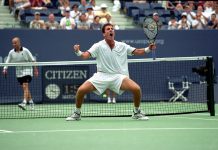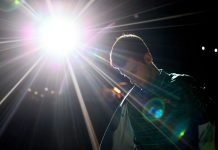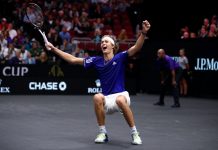 SAN FRANCISCO — Tom Brown was distinctive
SAN FRANCISCO — Tom Brown was distinctive
. It wasn’t just that his memoir —”As Tom Goes By” — was perhaps the best title of any tennis book ever. It wasn’t that, unbeknownst to many, he was a fabulous dad or that probably more than any other player he went from the top of the American and international game to dominate in regional play.
More than anything, he was known for his no-nonsense intensity. One day, “The Frisco Flailer” and Charlie Hoeveler were playing at the joyously chaotic Golden Gate Park courts, where, amidst all the distractions, their own rule was that no lets were allowed no matter what, except for armed hippies and wild animals. But deep into the match, Hoeveler called a let. Brown bristled, “You know there’re no lets.” “Wait a second,” countered Hoevler, “behind you there’s a hippie with a monkey on his back. That’s a wild animal.”
“Yes,” notes Hoeveler, “Tom was all business and was perceived as being super serious, almost arrogant. But he was a wonderful, hilarious guy — just terrific. He was absolutely great to be around. He practiced for every match as if it were a Wimbledon final. He was interesting and had great theories on the game. I adored him. Yeah, he was perceived as ‘Mr. Stonewall,’ but he was a prince of a guy.”
Brown, who reached the finals of the U.S. Championships in ’46 and Wimbledon in ’47 (only to fall to Jack Kramer both times), won the Wimbledon men’s doubles (with Kramer) and mixed (with Louise Brough) titles in ’46. Ranked in the top 10 in the U.S. eight times between ’46 and ’58, he rose as high as No. 4, and went on to rule in one age bracket after another in NorCal play. A product of Lowell H.S. and UC-Berkeley, Brown served in WWII. He had a wicked slicing forehand. His key was to pace himself. Still, he once won three singles tournaments in one day. He also collected the USTA National 65s and 70s on the same day, and won an ITF tournament in ’89 without losing a single game. In ’87, he won a Grand Slam in the 65s singles, winning on hard courts, clay, grass and indoors. Veteran standout Eugene Cantin explained, “Playing Brown was never an enjoyable experience. His concentration and intention to grind you into the dust was complete and unwavering.” Once an elite Eastern European player who was being schooled by Brown sagged in exhaustion and cried out to the crowd in a heavy accent: “Who is this old man?”
In ’69, 47-year-old Brown left 18-year-old Erik Van Dillen — then the possessor of the finest junior record in U.S. history — in the dust. After his five-set win, Brown jogged to the sideline. Van Dillen, cramping and exhausted, needed aid to get off court.
In his late 70s, Brown told his internist that he played three or four times a week, at which point the doctor replied, “If you don’t play more you’re going to die very quickly.” Brown immediately increased his play. He estimated that he played over 3,000 matches, often against far younger foes.
Former USTA NorCal chief Peter Herb recalled how he once ran a tournament in which Brown was entered in two age divisions. He had the possibility of playing four matches in one day. Herb asked, “How much time do you want in between matches?” Brown replied, “Just keep sending the next ones down and I’ll stay on the same court.” And sure enough, he played four consecutive matches on Court 5.
A San Francisco lawyer, Brown raised three daughters and a son and dealt with assorted injuries. A year after his shoulder was replaced he again climbed to No. 1 in the world. Few others have loved the game more or played with such ferocity for so long in so many arenas, little and large. Brown died from complications due to Alzheimer’s disease.


















